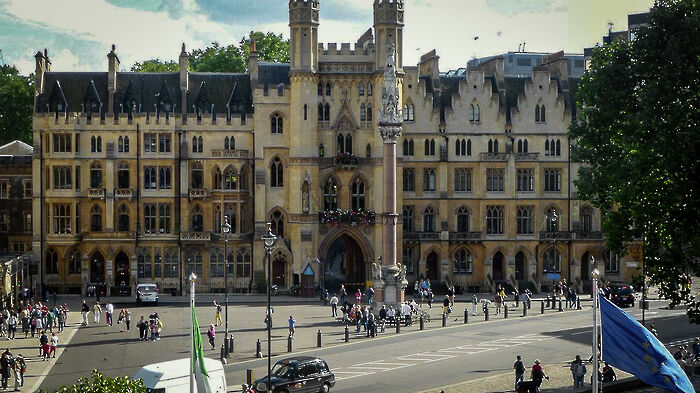Cambridge beats Oxford in key access metrics, but both lag behind national average
After Oxford’s admissions statistics drew criticism this week from several MPs, it’s worth taking stock of Oxbridge’s access record

Following the release of Oxford’s first annual admissions report earlier this week, David Lammy MP, a former education minister, claimed that Oxford is “lagging well behind” Cambridge in terms of state school access.
Still, Cambridge has also come under fire in recent years for what Olivia Hylton-Pennant, CUSU access officer, described as “disappointing but not surprising” admissions statistics. This is true of continued disparities in success rates for different ethnicities, with 2016 marking the first time the University accepted more black men than Etonians.
A comparison of the admissions statistics for the 2017 UK intake show that while Cambridge statistics regarding school type, ethnicity, and region favourably compare to Oxford’s, in most cases differences are marginal, as both have consistently lagged behind both Russell Group and national averages.
In perhaps the most obvious barometer of access – state school intake – Cambridge has consistently outperformed its rival, maintaining an average intake of 62.6% from the maintained sector, compared to Oxford’s 57.1%, over the past six years. Oxford is yet to receive an intake with over 60% hailing from the state sector. In the 2017 admissions cycle, both universities declared record highs, with 64.1% of Cambridge’s intake coming from state schools while at Oxford it was 58.2%.
However, more than 36% of Cambridge’s state school intake in 2017 was from selective grammar schools compared to 45.8% from comprehensives. This is despite the fact that comprehensives had almost double the applicants of grammar schools.
Oxford and Cambridge both fare worse than almost all of their Russell Group counterparts however, with UCL’s intake from the state sector standing at 67.6%, Bristol’s at 64.5% and Edinburgh at 66.4% for 2017. Across the UK as a whole, 90% of university students hail from state schools.
The Higher Education Funding Council for England’s participation of local areas (POLAR) classification divides regions of the UK into five, based on what percentage of young people from a particular area access higher education, with quintile one indicating areas with the lowest rates of access.
Despite strides made by Oxbridge in attracting applicants from the state sector, and overwhelming majority of Oxbridge intake comes from areas where young people are the most likely to attend university in the first place. Cambridge’s POLAR quintile 1 intake was just 4.5% in last year’s admissions cycle, while at Oxford the figure was a mere 2.8%. Both are substantially lower than the Russell Group high of 9.7% at Liverpool and the national rate of 11.4%.
In an effort to address this, earlier this month, Cambridge announced that it has been “collaborating with colleges” to introduce a foundation course by 2020 for students from disadvantaged backgrounds, a scheme already implemented at Lady Margaret Hall, Oxford.
Alongside state school intake, Oxford and Cambridge have been unable to shake off criticisms of a lack of ethnic diversity in their student intake. Racial disparities in admissions at Oxford are even starker than at Cambridge, with no BME group achieving more than a 20% success rate in the 2017 admissions cycle.
Arab and Pakistani applicants saw lowest success rates of any ethnic group, with 7% of Arab applicants admitted to Oxford and 13.1% at Cambridge, while 11% of Pakistani applicants were accepted at Oxford and 12.8% at Cambridge. This is compared to 23% of white applicants admitted to Oxford and 26.2% of white applicants admitted to Cambridge in its UK intake.
Success rates for black students are also strikingly low, with only 12.8% and 13% of black Caribbean applicants successful at Cambridge and Oxford respectively. The only ethnic group who had higher success rates than their white peers in the application process were Chinese applicants at Cambridge, 27.7% of whom were admitted, compared to just 18% at Oxford.
In total, 21.9% of the 2017 intake at Cambridge and 17.9% at Oxford were BME, which is lower than the average of 24.7% across all UK universities, although Cambridge fares better than the Russell Group average of 20.5%.
There continues to be a regional disparity in access efforts aimed at students in Scotland, Wales and Northern Ireland by both universities. A recent Varsity investigation revealed the extent of the problem at Cambridge in particular, with Wales only targeted by two colleges as part of the Area Links scheme, while London is targeted by 17 colleges despite only having three times the population. This is in spite of the fact that Wales has the highest rate of young people with no access to post-secondary education.
 News / Uni offers students £55k in payouts31 October 2025
News / Uni offers students £55k in payouts31 October 2025 News / Uni error forces deeper spending cuts31 October 2025
News / Uni error forces deeper spending cuts31 October 2025 News / Students allowed to use AI, says new uni guidance31 October 2025
News / Students allowed to use AI, says new uni guidance31 October 2025 News / Students launch women’s society excluding trans women31 October 2025
News / Students launch women’s society excluding trans women31 October 2025 News / College rowing captains narrowly vote to exclude trans women31 October 2025
News / College rowing captains narrowly vote to exclude trans women31 October 2025











